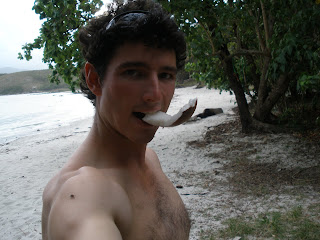We packed up our tent, had a muesli bar for breakfast and walked out to the main road to start our first full day exploring outside of Dili. We walked up the hill, and quickly came upon a shop, where we stocked up on water (the cheapest we ever bought in Timor), bought some coconut biscuits that were awesome, and sat at the bus stop opposite contemplating how to use public transport. We soon got chatting to a young bloke wearing a Barack Obama belt buckle who spoke good english, worked for the national electricity company connecting houses to the power (ie. Stringing lines from tree to tree), and whose family owned the shop opposite. He told us a bus to Aileu would be coming soon, and he hailed us the bus thankfully as it fairly sped up the hill, and we had no idea which one to catch, although there is really only one road. This one went to Suai on the far south coast. One of the guys I spoke to was going home for the first time since leaving for university. He is now a qualified engineer. Two hours of honking, twists and turns, big potholes, a guy throwing up out the window, and holding on so as not to be thrown out or push the two others I was sharing the door well with out, we arrived at Aileu.
We got off a few k's early to look at a demonstration farm I had read about on the net, and we saw the sign to on the bus. There was not much exciting to see except a rice dehulling machine, and their was no one around to talk to. So we walked into town, waving and chatting to people as we went (as with anywhere in Timor). When we arrived in the town centre it was market day, and we were the star attraction! We took a bit of a look around then attempted to buy some sweet looking bread balls/ We offered up a dollar and got given at least 20 of the things. Luckily they were good. We sat down and ditched the packs, and started giving away our bread balls, and talking to a stream of young Timorese keen to practice their english and talk to foreigners, even if it took some of them a long time to gather the courage.
We headed to lunch at a café kept afloat by UN traffic through the town, and featuring in the lonely planet. Little did we know this was the last proper meal we would have for a good little while. After lunch we walked on out of town, checking out what was around and waiting for transport to pass us by. We walked past the middle school at school finishing time, which made for a lot of 'good afternoons' in Tetum (Boa tarde) and giggling school girls. We headed back towards town to wait for a bus at the stop, when a lady we had spoken to on our way out invited us in for tea. A bit more chatting, plus awkward silences, a cup of tea, and no sooner had we finished than a yell from the other lady outside indicated transport was here. We hurried out, and jumped on the back of an Anguna. An anguna is just a small truck with an open back, a bench seat down either side, and a bit of a cage to hang onto. We had our feet up on the closer tail gate, hanging onto the steel bar. There was Roland and I with our packs on, and three other guys on the tail gate, so you can imagine how many were sitting down. When in Timor, if you are not in a hurry (and its not raining) these things are the way to travel. You get fresh air, an awesome view of the country side, it is really easy to met people from all demographics, and you see Timorese life in action.
 Sarah made it to the east with no flat tyres and only 2 services
Sarah made it to the east with no flat tyres and only 2 services  Archer Point. The small groyne has a rusty wharf that supplied the old lighthouse and an outpost in WW2
Archer Point. The small groyne has a rusty wharf that supplied the old lighthouse and an outpost in WW2








